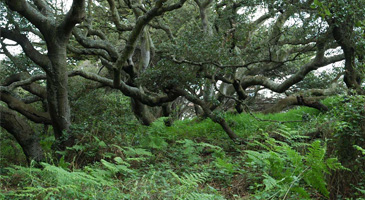
Coined in 1930, the word ecosystem means all the physical and biological components of an environment. It includes all the organisms living in an area, along with all the non-living physical components that interact with organisms, such as air, soil, water and sunlight. Ecosystem services are fundamental life support services upon which human civilization depends. Ecosystems provide our sustenance, including our food, water and medicine; supply us with wood, paper and minerals; regulate our climate; and provide cultural services, such as recreation.
Coastal Scrub
Coastal scrub habitat is found throughout much of the city. Small remnants of these ecosystems support a unique array of plants and animals.
Sand Dunes
Much of San Francisco was once covered in sand dunes. Today the largest sand dunes can be found at Fort Funston. Small remnants of these ecosystems support a unique array of plants and animals.
Pacific Ocean
80% of San Francisco's 232 square miles consists of water, with most of that west of the Golden Gate. A tremendous array of life can be found in this expanse of water, which includes the Farallon Islands, a national wildlife refuge supporting the largest seabird colony in the continental United States.
San Francisco Bay
The San Francisco Bay supports nearly 500 species of fish, birds, mammals, amphibians, and invertebrates. It is an essential resting place, feeding area and wintering ground for millions of birds. Nearly two-thirds of the state's salmon pass through the Bay during their migration.
Oak Woodlands
Oak woodlands are among the most characteristic of Bay Area plant communities, and made up the only wooded areas of San Francisco prior to human habitation. Harboring many insects, birds and mammals, they can be found on Yerba Buena Island, in Buena Vista Park, and in Golden Gate Park.
Riparian
Riparian ecosystems are environments along a watercourse or above an unusually high water table. They purify water by removing contaminants, control erosion and provide habitat for a variety of plants and animals. In San Francisco, they can be found in Glen Canyon Park, Pine Lake Park, McLaren Park, the Presidio and Lake Merced.
Salt Water Wetlands
Wetlands are among the most important ecosystems worldwide. They produce high levels of oxygen, filter chemicals, reduce flooding and erosion, recharge groundwater, and provide critical habitat. There are many different kinds of wetlands, and San Francisco has several, including freshwater, saltwater and riparian.
Fresh Water Wetlands
Among the most important ecosystems in the world, wetlands produce high levels of oxygen, filter chemicals, reduce flooding and erosion, recharge groundwater, and provide critical habitat. The 509-acre Lake Merced and the 14.2-acre Mountain Lake in the Presidio are fresh water wetlands.
Grasslands
Formerly the most common habitat in San Francisco, remnants of grasslands support a wide array of wildlife. Twin Peaks, Bernal Hill, Billy Goat Hill, Bayview Hill, Mount Davidson, Corona Heights. McLaren Park, and Glen Canyon Park all have thriving grasslands.
Coastal Scrub is one of the predominant remaining natural communities in San Francisco. This maritime plant community thrives in the fog belt from Mendocino County to San Diego County, and is dominated by coyote bush, California sage brush, poison oak, California blackberry and occassional stands of California coffeeberry.
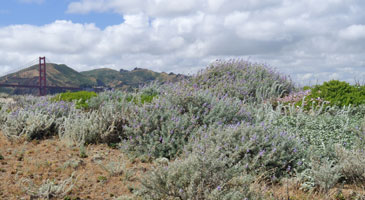
The Presidio contains a unique serpentine (the state rock) variant of coastal scrub that still includes a serpentine chaparral community, supporting many rare plants, as well as significant stands of blue blossom ceanothus. This unique ecosystem is found along the coastal bluffs north of Baker Beach, as well as near Fort Point and behind Crissy Field.
Coastal scrub habitat can be found in Glen Canyon and on Twin Peaks, where we have iconic slopes of California sage in view of downtown. Coastal scrub used to be the predominant habitat on Mount Sutro as well as Mount Davidson, where a deciduous shrub - dominated version still thrives along with San Francisco's only stand of native huckleberry. This area of Mount Davidson has some of the best birding in the city due to its rich coastal scrub habitat.
Plants Mentioned
California blackberry
California coffeeberry
California sage brush
Coyote bush
Native huckleberry
Poison oak
Sand Dunes. Much of San Francisco was once covered in sand dunes. Golden Gate Park is located on what once was part of the largest inland-reaching sand dune ecosystem in the western hemisphere. The dunes stretched for seven miles from Ocean Beach to what is now the Financial District. Most of these dunes are now gone, although about 2 square miles of underwater sand dunes remain just west of the Golden Gate.
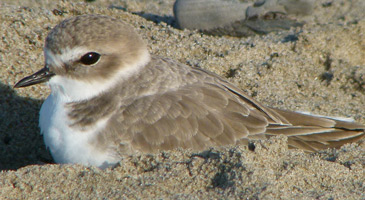
Dune plants commonly have small, waxy or succulent leaves, allowing them to survive in dry, nutrient–poor sand while being battered by wind and salt spray. Common native plant species include dune strawberry, beach burr and yellow sand verbena.
The coastal strand is the dune community that takes the frontal blast and is most subject to salt spray. Some dune plants, such as the rare Lessingia germanorum, benefit from the movement of the sand. Behind the coastal strand are the foredunes, usually more stabilized and supporting some perennial vegetation.
The largest remaining sand dune field can be found at Fort Funston, where the dunes can reach the height of 200 feet. Fort Funston is also home to a colony of bank swallows, a state threatened bird species that nest in the cliffs above the ocean.
In the late 1800s and early 1900s European beachgrass and iceplant were widely introduced to control erosion and stabilize sand dunes. Unfortunately, that stabilization prevents the natural movement of sand and facilitates the loss of the indigenous dune community.
Places: Fort Funston, Golden Gate Park, Ocean Beach, Financial District
Plants: Dune strawberry, beach burr, yellow sand verbena, Lessingia germanorum
Animals: Bank swallows, plover
Pacific Ocean. 36 species of marine mammals have been observed in the Gulf of the Farallones, just off the west coast of San Francisco. This includes 28 species of whales, dolphins and porpoises; 6 seal and sea lion species and 2 otter species. Gray, humpback and blue whales; Pacific white-sided dolphins; Harbor and Dall’s Porpoises; California and Steller sea lions; Northern fur, Northern elephant and Harbor seals are common.
Every fall, one of the world’s largest concentration of Great White Sharks come to the Farallon Islands to prey on elephant seals and sea lions, with male sharks showing up every year, and female sharks showing up every other year. While no one knows for sure how more Great White Sharks live in the Pacific Ocean, they probably number no more than a few hundred. Smaller males can be up to 13 feet in length, whereas the larger females can be up to 19 feet in length.
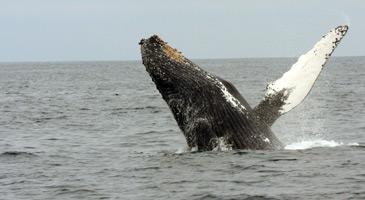
In addition to the Great White Shark, other fish species that can be found include Chinook Salmon, the Cookie Cutter Shark, the Delta Smelt, Mola Mola (Sunfish), Pacific Herring and Tidewater Goby.
Go to the California Marine Protected Areas website of the US Fish and Wildlife Service to learn more about our local Ocean's web of life.
More than 300,000 seabirds nest annually on the Farallon Islands – the largest concentration of seabirds in the contiguous United States. More than 400 species of birds have been observed on the islands. In addition to the 13 species that have breeding colonies on the islands, more than 160 species regularly use the sanctuary for shelter, food, or during migration. The world’s largest colonies of Western Gulls and Ashy Storm-petrels (an endangered species) can be found on the islands.
The incredible diversity of wildlife in the Gulf of the Farallones would not exist without the coastal upwelling that brings cool, nutrient-rich water up to support ocean life. The gulf contains one of only five coastal upwelling zones in the world. While coastal upwellings make up only one percent of the ocean, they support 50 percent of the world’s commercial fish catches.
95% of all animal species found here are invertebrates. One of the most important of these is the euphausiid shrimp, or krill. During the upwelling season, more than 100,000 krill per cubic yard can be found at the surface of the gulf. Krill feeds animals as large as the Blue Whale, the largest animal that has ever lived (bigger than any dinosaur).
Both Leatherback and Green turtles can be found in the ocean around the Farallons. Leatherback turtles are the largest turtles in the world, measuring up to 8 feet long, and weighing up to a ton.
San Francisco Bay. More than 70 native fish species can be found in the San Francisco Bay. Many of these species are transients, short term visitors from nearby ocean or freshwater habitats. Some are migrants, such as Chinook salmon and sturgeon, crossing the Bay between the ocean and their spawning grounds in rivers. 33 species of native fish are completely dependent on the Bay, living and raising their young here.
In addition to the native fish species, a number of other fish species have either invaded the Bay, or have been introduced. Striped bass, for example, were introduced in 1879 for fishing. Although the number of introduced and invaded fish species has increased, the Bay fish community is still dominated by native species.
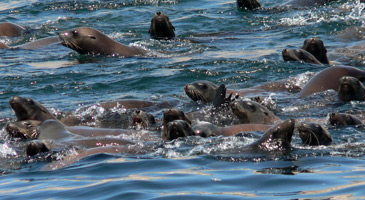
Eleven species of shark call the San Francisco Bay home, with at least five species living in the Bay year-round. The six foot long Leopard Shark is the most common and the most colorful of the shark species found here. Harmless to humans, it feeds on crabs, shrimp and herring.
In addition to the occasional lost minke or gray whale, four species of marine mammals are often seen in the Bay. Large numbers of California sea lions haul out at Pier 39, presumably because it’s a safe place away from predators. Sea lions do not breed in the Bay, but show up after breeding has finished in the Channel Islands in southern California in August, with some sea lions present all year. These highly social mammals are very vocal and can almost always be found somewhere in the Bay.
Pacific Harbor Seals haul out at Yerba Buena Island, and actively forage in the Bay all year. Harbor porpoises have recently returned to the Bay. Historically present in small numbers, they vanished from the Bay by the 1940s, due to ship traffic and environmental degradation. The final straw for these sensitive mammals was probably the steel net the navy installed between Sausalito and San Francisco during World War II to protect the harbor from submarine attack. Harbor porpoises are among the most elusive of the marine mammals and usually a quick view of a dorsal fin is all a human observer will see.
Bottlenose dolphins are now found regularly. Prior to the 1982-83 El Nino that brought warm water to northern California, these playful animals were rarely seen north of southern California. The expansion of warm water allowed them to range further north, and when the water cooled, the dolphins stayed, expanding their range.
More than a million birds stop or stay on the San Francisco Bay. It’s a critical stopover and wintering spot on the Pacific Flyway for many species of shorebirds and waterfowl. More than 300,000 shorebirds show up every year and the number of ducks can be in the hundreds of thousands every winter.
Oak Woodlands. Savanna-like oak woodlands are among the most characteristic of Bay Area plant communities, and the only wooded areas of San Francisco prior to European settlement. Dominated by oak trees, these complex and diverse habitats harbor more wildlife than any other terrestrial plant community in the Bay Area. Coastal live oaks grow in sheltered ravine areas, and a remnant area of this ecosystem was left intact when Golden Gate Park was created.
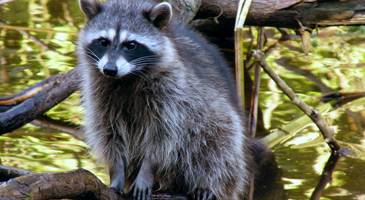
Oaks can be either deciduous or evergreen. The oak species found in San Francisco is the evergreen Coast Live Oak. The oak tree provides sustenance for many birds and mammals. Gray squirrels and scrub jays are voracious consumers of acorns from oak trees. Scrub jays may bury several thousand acorns in one season. By hiding and sometimes forgetting about their food stashes, Scrub Jays are planting future trees.
Oaks provide habitat for a variety of birds and insects. Coast live oaks host more species of small moths, for example, than any other plant species on the San Francisco peninsula. Small forest birds, such as the Chestnut-Backed Chickadee and the Hutton’s Vireo, depend on oaks for nesting and feeding habitat. Sapsuckers drill into the bark for food, Western harvest mice consume bark and Botta’s pocket gophers eat the roots of saplings. Insectivorous birds such as Brown Creepers and Nuthatches feed on insects residing on the trunks, branches and leaves of oaks. Oak trees are especially valuable to the many species of migratory birds that are in San Francisco for only part of the year.
Insects and mammals find new leaves on oak trees particularly tasty. The oak tree combats this predation by producing tannins and other chemicals distasteful to herbivores. As a result, animals are discouraged from eating too many leaves, allowing saplings to survive.
Oak acorns were a staple food source for the Ohlone in San Francisco. Oaks provided the wood for bowls, utensils, and fires. The Ohlone also used tannins from oaks for dye and tattooing. Tannins were also used to treat a variety of ailments from fevers to gastrointestinal problems. Oak bark was used for tanning hides by European settlers and oak charcoal was used to make mortar, plaster and fertilizer.
The oak woodland community may also include toyons, pink flowering currant, osoberry, coffee berry and many other species.
Oak woodlands can be found on Yerba Buena Island, in Buena Vista Park, and in Golden Gate Park at Coon Hollow, Casino Hill, Chicken Hill, Strawberry Hill, Whiskey Hill, and McLaren Ridge.
Riparian. A riparian ecosystem is an environment found along a watercourse. Willows, other deciduous trees and shrubs dominate this ecosystem in San Francisco. Streamside trees, shrubs and other plants purify water by removing contaminants, control erosion and flooding and increase available water by maintaining stream banks. Riparian ecosystems (derived from the Latin word ripa for river bank) provide habitat for a variety of plants and animals.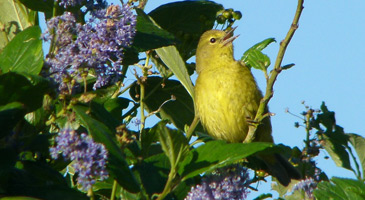
Remnant riparian habitats exist today in Glen Canyon Park, Pine Lake Park, McLaren Park, the Presidio and Lake Merced. Willow riparian woodland can be found along Lobos Creek in the Presidio, at the northern side of Mountain Lake, and along the El Polin Spring/Tennessee Hollow area. Mountain Lake and Tennessee Hollow also have riparian scrub habitat. An oak riparian woodland can be found next to Lobos Creek.
The free-flowing North Fork of Islais Creek in Glen Canyon Park supports riparian habitat. The largest remaining creek with public access in San Francisco, it is surrounded by willow thickets, and has a year-round natural flow. The vegetation along the creek provides a habitat for a variety of animals, including skunks, opossums, raccoons, hawks, owls, coyotes and the native and endangered San Francisco forktail damselfly.
Pine Lake Park, in western San Francisco, next to Stern Grove is in a valley that contains Pine Lake. One of the few remaining natural lakes in San Francisco, it is fed by the same aquifer as Lake Merced. The willow, tule and other wetland plants around the lake provide habitat for a variety of resident and migratory bird species.
Yosemite Creek in McLaren Park feeds Yosemite Marsh, and supports riparian vegetation. The creek flows downhill towards Candlestick Point, mostly through underground culverts, and terminates in Yosemite Slough.
A remnant riparian habitat can also be found along Stanley Creek which can be found next to Lake Merced Boulevard, at the corner of Brotherhood Way.
San Francisco had many miles of riparian habitat before most of our creeks were buried in culverts.
Saltwater wetlands, or marshes, are ecosystems dominated by shrubs and grasses influenced by saltwater tidal inundations and fluctuations. Daily tidal flooding brings in nutrients to the wetland to feed a number of salt -adapted species of plants and animals. A saltwater wetland acts as a buffer shielding land from severe weather, and detoxifies wastes brought in by the tides on a daily basis. Microorganisms in saltwater marshes neutralize pollutants found in water.
Saltwater wetlands are one of the most biologically productive habitats on earth, rivaling tropical rainforests, and are accorded a high level of protection by the Clean Water Act. Although eighty percent of this type of habitat has been lost to development in the San Francisco Bay Area over the past 200 years, new efforts are being made to restore these marshes.
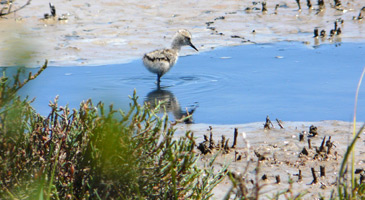
None of San Francisco’s original salt marshes – once quite extensive -- remain. But due to benign neglect and nature’s own healing power, wetland habitats have developed on several areas of bay fill. One example is at Heron’s Head Park (looks like a Heron’s head when viewed from the air) in the Bayview. Formerly known as Pier 98, this 25-acre parcel of non-permitted fill was slated for removal before the discovery of the developing ecosystem led to the expansion and enhancement of the wetlands and uplands habitats instead. Hundreds of volunteers participated. A Field Guide to 100 Birds of Heron’s Head documents bird species that can be found in this saltwater wetland. In the summer of 2011, for the first time in San Francisco in many decades, a pair of endangered Clapper Rails raised two young - at Heron’s Head Park.
One of most successful examples of saltwater wetland restoration in San Francisco is Crissy Field in the Presidio. An 18-acre tidal marsh was restored between 1998 and 2000, alongside the rehabilitation of 16 acres of dune habitat, which collectively support 105 different species of shrubs, wildflowers and marsh plants. Crissy Field has a long human history – first as a 130-acre salt marsh which served as a gathering site for the Ohlone, then as a landing site for Spanish, Russian, and English traders, then as a U.S. airfield, and now as a restored wetland. More than 135 bird species can now be found at Crissy Field, along with 25 fish species, and over 100 invertebrate species.
Other saltwater wetlands in San Francisco include a 1.5-acre wetland at Pier 94, the 34-acre Yosemite Slough at Candlestick Point State Park (scheduled to be fully restored by the spring of 2013) and the edges of Mission Creek and Islais Creek channels.
Freshwater Wetlands. Wetlands are among the most important ecosystems in the world. They produce high levels of oxygen, filter chemicals, reduce flooding and erosion, recharge groundwater, and provide critical habitat for plants and animals. They can be permanent or seasonal. Prominent wetland plants, such as cattails, reeds and tules, are effective biofilters, breaking down harmful pollutants. Wetlands provide a resting stop for migrating birds in the fall and spring, and support thousands of wintering birds in the City.
The 509-acre Lake Merced, located in the southwestern corner of San Francisco, is the largest freshwater wetland between Pt. Reyes in northern Marin County and Pescadero Marsh in southern San Mateo County. The lake provides critical habitat for more than 200 species of birds, and nesting habitat for 70 species when you include its surrounding uplands. A number of bird species that are considered locally vulnerable or threatened are found in this habitat, including the Common Yellowthroat, the Yellow Warbler and the Green Heron.
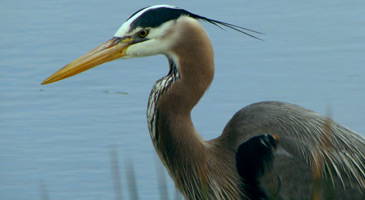
Lake Merced was once home to deer, elk and a number of other mammals, but today the only mammals commonly found around the lake are the California Vole and House Mouse. However, muskrat, striped skunk and Virginia opossum have been observed at Lake Merced. Historically, the Lake was valuable hunting territory for the local Ohlone villages, as well as a source of non-food necessities. The Ohlone people made boats, houses, baskets and sleeping mats from the tule rush at Lake Merced. Following the original poisoning of native fish species in the lake, more than 20 species of fish have been introduced or re-introduced to Lake Merced, providing food for humans, cormorants, herons, kingfishers and osprey. Reptiles and amphibians present at Lake Merced include the western skink, the northern alligator lizard, the introduced red-eared slider and soft-shell turtles, California slender salamander and the California red-legged frog.
Friends of Mountain Lake, the Golden Gate National Parks Conservatory, the Presidio Trust, the National Park Service, and the California Academy of Sciences are working to help restore Mountain Lake through toxics remediation and the removal of non-native species of plants, and planting native species. The 14.2 acre lake and its vegetated banks provide habitat for fish, birds, mammals, reptiles, amphibians and numerous invertebrates.
Grasslands. Dominated by numerous species of annual and perennial grasses (red fescue, purple needlegrass, etc.), the grassland community also includes a huge diversity of flowering plants such as goldenrod, footsteps-of-spring, checkerbloom, Johnny jump-ups (now rare), shooting stars, lupine, and many more. Grasslands provide colorful spring wildflower displays and produce seeds, bulbs and nectar for many animal species. The deep-rooted perennial bunchgrasses play an important role in holding the soil and preventing erosion.
For millions of years, California’s original grasslands were grazed, browsed and trampled by now-extinct megafauna such as ground sloths, camels and mammoths. After these mammals became extinct 10,000 years ago, they were replaced by antelope, deer, bear and small mammals. Native Californians were the first humans to intensively manage grasslands, primarily through annual burning.
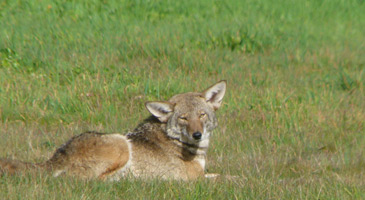
With the arrival of European settlers, the indigenous grasslands were almost entirely displaced by non-native species. Brought in with the domestic livestock industry, non-native species have become the most abundant plants in California’s grasslands, including in San Francisco.
Grassland habitats support a wide array of wildlife, including mammals, birds, amphibians & reptiles, insects and other invertebrates. Historically, the most common plant community in San Francisco was coastal prairie (prairie is the French word for meadow), treeless grassland that covered most of the City.
San Francisco also supports serpentine grasslands. Serpentine is a mineral that produces a nutrient-poor soil, often containing pockets of naturally occurring heavy metals toxic to plants not specially adapted to its distinctive chemistry. This rare ecosystem supports a number of unique species of plants and animals.
Today grasslands in San Francisco can be found mainly on our hills, including on Twin Peaks, Bernal Hill, Billy Goat Hill, Bayview Hill, Mount Davidson, and Corona Heights. McLaren Park and Glen Canyon Park also have important grasslands. A special area of serpentine grassland is being restored at Inspiration Point in the Presidio.